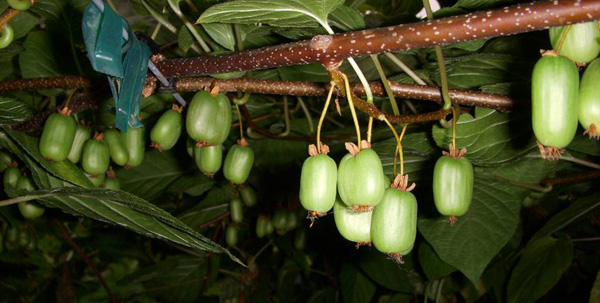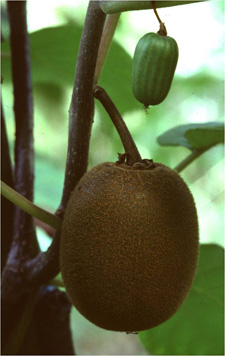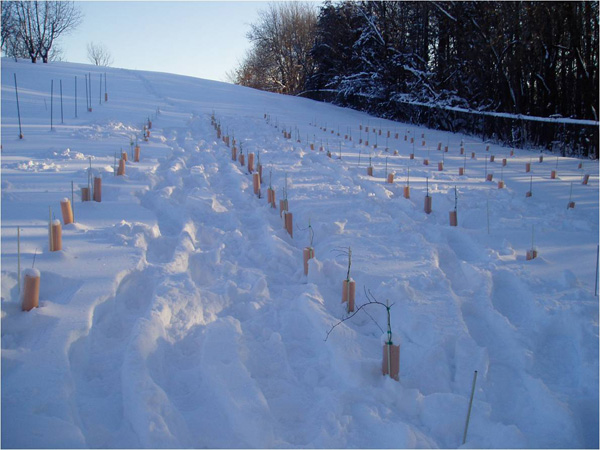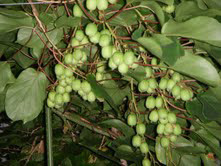
“I would not live in Minnesota because you cannot grow apples there.” — Horace Greeley
Bob Guthrie – geologist, environmental scientist, and cold hardy kiwifruit advocate — references Greeley’s quote during a discussion about growing cold hardy kiwis in Minnesota. The point he intends to make: First assumptions are not always correct. In this case, the 30 successful apple varietals released by the University of Minnesota since 1920 refute Greeley’s claim. Guthrie then links Greeley’s quote to another, which is similar in nature but references kiwi vines rather than apple trees: “A rampant growing ornamental vine from Japan … has been found to be unreliable. We cannot advise planting as there are more desirable vines.” — Samuel B. Green, professor of horticulture, University of Minnesota, 1905.
A Lifetime Passion
For the past two decades Guthrie has worked to prove Green’s premise wrong. “Look at us now. We have a Honeycrisp apple. We can do the same thing with kiwifruit,” he says. His work with kiwi vines dates back to 1990, when he planted his first vines in the backyard of his rental duplex. Guthrie found the varietal he used could not survive a Minnesota winter, and upon buying a home in Roseville in 1992, started acquiring and planting additional vines that could. Since that point his kiwifruit activities have increased significantly.
At the suggestion of Jim Luby, a longtime friend and fruit-breeding professor at the University of Minnesota, Guthrie started volunteering at the University’s Horticultural Research Center in Victoria in the early 1990s (the HRC was growing one row of kiwi vines at the time). Since then, Guthrie has collaborated with Luby and other investigators on cold hardy kiwi research, expanded the HRC’s collection, helped with two grant proposals, performed countless hours of care and research, visited several commercial kiwifruit orchards, and attended international kiwifruit symposiums. Since 1996 he’s also crossed different kiwifruit species in order to develop one that can tolerate Minnesota winters and, of course, be tasty. Oh, and this is all on his own time. “My wife Jenny and three kids would likely tell you that it is a bit more than a hobby, but it does keep me out of trouble,” he says.
What is Cold Hardy?

Cold hardy kiwis don’t look like the typical brown fuzzy, green-fleshed fruits you see at the grocery store (typically a varietal named Hayward, see left for comparison). They’re grape-sized and fuzz-free. Much like a grape, you can pop them in your mouth, skins and all. Cold hardy kiwis can withstand below-freezing temperatures, unlike the Hayward kiwis, which are sensitive to cold and unable to survive temperatures below 10 degrees Fahrenheit.
There are three cold hardy kiwi varietals that can survive the Minnesota cold: Actindia kolomikta (Arctic Beauty), A. arguta (Bower Berry), and A. polygama (Silver Vine) — though the latter two flourish only in southern parts of the state – USDA Hardiness Zone Four. A. kolomikta and A. arguta have smooth green skins, whereas A. polygama turns from green to orange upon ripening. The skin and flesh of some varieties of A. arguta can range from green to red to purple. They also taste much sweeter than your standard kiwi – sugar contents of cold hardy kiwis are higher than the Hayward varietal. These cold hardy kiwifruits make an excellent snack or addition to a salad. They can also be dried, like raisins, or used to make a sweet wine.
Cold hardy kiwis are not new to Minnesota. They were growing here long before Guthrie or the HRC began their research. Their first recorded existence dates back to the late 1892. The plants belonged to R.J. Mendenhall (a Minnesota businessman) and his wife Abby, and grew at their home — Guilford Place, located in Minneapolis at Lake and Nicollet. Though not a horticulturist by profession, Mendenhall’s lot and surrounding nurseries were, at the time, regarded as “one of the foremost in the country.” As mentioned above, Green, the first professor of horticulture at the University of Minnesota, also reported on cold hardy kiwis at the turn of the 20thcentury. It’s likely that he was familiar with kiwi vines prior to their Minnesota introduction thanks to one of his professors at the Massachusetts Agricultural College (now University of Massachusetts), who brought seeds to the United States from Japan in 1876. After Green’s death in 1910, the statewide interest in kiwi vines diminished until the mid-1980s, eventually becoming an area of interest for investigators such as Guthrie.
Current Research
Guthrie is currently working alongside fruit-breeding staff at the University of Minnesota and Eric Theship-Rosales (a master ship-wright and wooden boat restorer / rebuilder) to advocate for commercial production in Minnesota and develop a cross that would thrive in a Minnesota climate. Recently they’ve reached a few milestones. In 2006 the team was given a small USDA grant that they used to establish Theship-Rosales’s organic kiwifruit orchard in Chanhassen. At this time there are 300 plants at the site. Theship-Rosales hopes to plant 500 more. The grant ended in 2009, but Luby and Guthrie plan to submit another proposal this year to acquire some specialized testing equipment.

In the meantime he’s been making crosses in his own backyard, experimenting with kiwifruits of varying shapes, flavors, and climatic needs. He’s found that by crossing A. kolomikta (Arctic Beauty — the most cold hardy) with less cold-tolerant species, he’s been able to marry climate sustainability with palate-friendly flavors. “I plant promising seedlings at the HRC for trial and evaluation,” he says. This year he plans to grow more than 2,000 seedlings. There’s already been one success story at the HRC. “One particular vine produces an abundance of large berries with excellent flavor and storage characteristics,” he says. Guthrie is working to create a varietal that produces a high yield, ripens early, has a long storage life, and, perhaps, a strong color change indicator to signify ripeness (adding ease to harvest).
Growing Your Own

It’s unlikely you’ll be able to buy a locally grown cold hardy kiwifruit from your grocer for several years. Much like a new apple varietal, which can take 20 years to develop, a significant amount of time and money will be spent to develop a kiwi varietal suitable and commercially worthy to Minnesota and other cold climate areas. In the meantime, amateur gardeners can try to grow them in their own backyard. Linder’snursery plans to carry kiwi vines this season (they’ll be available late April). Gertens does not plan to carry any, and Bachman’s is still undecided.
Only one male vine produces enough pollen for six female plants. A few considerations before planting: The growing site should be sloped, shaded from afternoon sun, have well-drained soil, and organic matter. Guthrie recommends using organic mulch, such as wood chips, leaves, or pine needles, to cover the soil and retain moisture. Vines will need something to latch on to, as they grow upward in a counter-clockwise direction. Using a pole or trellis or planting next to a chain-link fence are all good options. They’ll need supplemental irrigation during dry periods, so be prepared to water frequently if rainfall is sparse. The University of Minnesota’s website has in-depth information on growing kiwifruit at home.
Building Awareness
Guthrie’s passion to advance kiwifruit growth won’t be tapering anytime soon. “Cold hardy kiwifruit has a colorful history, and, I think, a bright future,” he says. He’s entered his kiwis in the Minnesota State Fair amateur fruit contest for several years. Last year his kiwis placed first in the “any other fruit” category (kiwis are small potatoes compared to apples and grapes). “I do it for exposure. I’m hoping they eventually create a kiwifruit category. That’s my life ambition.”

We’re going to try growing them this year. We ordered Artic Beauty from Hartmann’s nursery in MI.
I am so freakin’ excited about this! Emailed my mom to see if we can plant a couple vines in her garden
If my peach trees survived this year I’ll try Kiwis next!
I’d never even heard of this kind of kiwi and lo and behold, spotted some at the store today. I shelled out $3.99 for a small package out of sheer curiosity.
This is totally awesome! I may have to built a trellis just to grow these guys. I had “baby kiwi” the first time a few years ago and they’re are just as delicious (and easier to eat!) that the original kiwi. I’ve also become obsessed with growing them since I saw my first kiwi vine while hiking in Anacapri 7 years ago.
We’re going to be selling Arctic Beauty (the male plant) and Red Beauty (the female) at this year’s Friends School Plant Sale. Our catalog will be available soon (by March 25) on our website. We’re excited too! Go hardy kiwis!
I love kiwis so was surprised to see the local Lowes selling kiwi plants in the nursery section of the store. Will try my luck out and purchase several of the plants.
I’m in Akron, NY about 20 miles outside of Buffalo, NY. Figured if they’ll survive in Minnesota they sure as heck should be able to survive here.
I just saw that in Japan, Actinidia polygama (silver vine) is noted for having an effect on cats much like that of catnip. Does anyone know where I can get a stick to see if my cats like it?
I have a male and a female vine growing. They have been growing about 3 years now. So far the plant is doing great and getting big. I have not had any fruit from it yet but hopefully I will in the years to come!